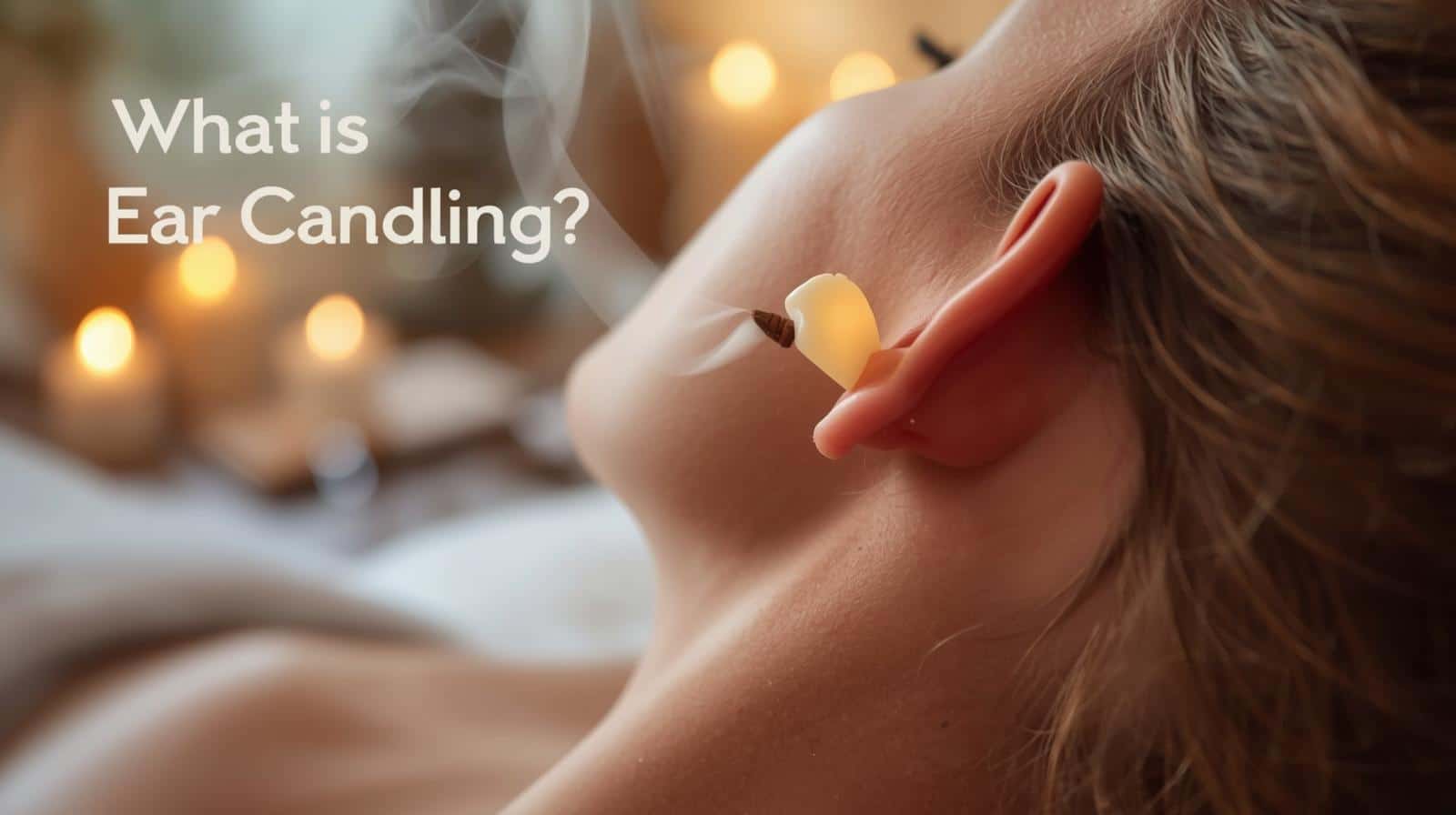Table of Contents
Ear care is an important part of overall health, yet many people still turn to unconventional practices to clean or “detox” their ears. One such method is ear candling—a technique that has been around for centuries but remains controversial today.
Proponents claim that this practice removes earwax, improves hearing, and even relieves sinus problems. However, medical experts warn that ear candle therapy is not scientifically supported and carries real risks. In fact, safe, evidence-based alternatives are available for managing earwax and maintaining ear health.
In this article, we’ll break down everything you need to know about ear candling—how it works, what the risks are, and what safer ear cleaning options you should consider.
What is Ear Candling?
Ear candling, also known as ear wax candling or thermal-auricular therapy, involves inserting a hollow, cone-shaped candle into the ear canal and lighting the outer end. The candle is typically made of cloth soaked in beeswax, paraffin, or soy wax.
Supporters believe the burning candle creates suction that draws out earwax, toxins, and other impurities. After the session, the leftover debris inside the candle is often presented as “removed earwax.”
However, research shows that this residue is not earwax at all—it is simply a byproduct of burned wax and fabric.
However, research shows that this residue is not earwax at all—it is simply a byproduct of burned wax and fabric. Safer options such as hearing aid repairs and adjustments or consulting a hearing specialist in Singapore, provide reliable care for ear and hearing health.
A Brief History of Ear Candling
Ear candling is thought to have originated from ancient cultures such as the Hopi Native Americans, Chinese, and Egyptians. Traditionally, it was used in ritualistic or spiritual practices rather than as a medical treatment.
Over time, it has been marketed as a natural therapy for:
- Removing earwax
- Improving hearing
- Relieving sinus congestion
- Treating tinnitus
- Reducing headaches
Despite its popularity in wellness circles, modern science does not support these claims.
How Ear Candling is Supposed to Work
The process usually goes as follows:
- A person lies on their side with one ear facing upward.
- A hollow candle, about 20–30 cm long, is placed into the ear canal.
- The outer end of the candle is lit, while the inner end is held in place.
- The candle burns for 10–15 minutes, supposedly creating a “vacuum” effect.
- The candle is removed, and the charred remains are cut open to reveal residue.
Practitioners suggest this residue is a mix of earwax and impurities. But in controlled studies, the same residue appeared even when the candle wasn’t inserted into the ear—proving it is just burnt wax.
The Claims vs. The Facts
Common Claims:
- Clears earwax naturally
- Improves hearing and balance
- Relieves sinus pain and pressure
- Helps with tinnitus and headaches
- Detoxifies the body
Medical Facts:
- No scientific evidence supports these claims
- Ear candling does not create enough suction to remove earwax
- Residue is not earwax but candle byproducts
- Reported benefits are placebo or temporary comfort from warmth
Ear Candling Safety Concerns
Ear candling safety is one of the biggest issues raised by hearing specialists. The procedure comes with several risks, including:
- Burns to the face, ear, or scalp – from dripping hot wax
- Blockage of the ear canal – melted wax can clog the ear, worsening the problem
- Perforated eardrum – inserting candles into the ear canal can damage the delicate eardrum
- Hearing loss – if hot wax or candle fragments reach the middle ear
- Infections – bacteria may enter if the ear canal is injured
Ear Candle Risks: What Can Go Wrong
The risks are not hypothetical—case studies have documented actual harm. Some patients have needed surgery to remove wax blockages caused by candling, while others suffered permanent hearing damage.
Documented Complications:
- Severe burns from dripping wax
- Candle wax hardening inside the ear
- Ear canal obstruction
- Ruptured eardrums
- Middle ear infections
- Temporary or permanent hearing loss
Clearly, the ear candle risks far outweigh any perceived benefits.
Why People Still Try Ear Wax Candling
Despite warnings, ear candling remains popular for a few reasons:
- Misinformation online – Many wellness blogs promote it as “natural” and “safe”
- Visual proof – The wax residue misleads people into thinking it works
- Cultural influence – Some communities still practice it traditionally
- Desire for alternatives – People seek non-medical solutions for earwax buildup or tinnitus
This is why hearing professionals stress the importance of education and safe alternatives.
Alternative Ear Cleaning Methods
Instead of ear candling, safe and effective alternative ear cleaning methods include:
- Professional Earwax Removal: An audiologist or ENT doctor can safely remove earwax using suction, irrigation, or special instruments.
- Ear Drops: Over-the-counter ear drops can soften wax, making it easier for the ear to naturally expel it.
- Irrigation at a Clinic: A controlled water flush performed by a professional can clear excess wax.
- Regular Hearing Check-Ups: Routine visits to a hearing specialist in Singapore help monitor ear health.
The Role of Audiologists in Safe Ear Care
If you’re experiencing earwax buildup, tinnitus, or hearing loss, the safest step is to consult a qualified audiologist. At The Hearing Centre Singapore, services include:
- Audiometry Test Singapore – to check your hearing health
- Hearing Loss Treatment Singapore – for patients with reduced hearing
- Tinnitus Treatment Singapore – safe management without risky methods
Unlike ear candling, these methods are safe, medically approved, and effective.
Why Ear Health Should Not Be Taken Lightly
Hearing is vital for communication, learning, and quality of life. Ignoring ear health or relying on unproven methods like ear candling can make problems worse. Early detection through professional hearing tests ensures that issues such as ear infections, tinnitus, or hearing loss are managed promptly.
Conclusion
So, what is ear candling? It is an alternative practice that claims to remove earwax and improve ear health but has been proven ineffective and unsafe. The so-called benefits are not backed by proof, and the risks—including burns, ear damage, and hearing loss—are very real.
Instead of turning to ear candle therapy, it’s best to consult hearing care professionals who can provide safe, effective solutions. If you’re concerned about earwax buildup, tinnitus, or hearing changes, schedule a consultation with a trusted audiologist.
Your ears are delicate—don’t risk them with unproven methods.
Frequently Asked Questions
Ear candling is a traditional practice where a hollow wax-coated candle is inserted into the ear and lit on the outer end. Supporters claim that the heat and smoke create suction that draws out earwax and toxins. However, medical research has shown that this method does not work as intended.
No, it does not. Scientific studies confirm that the process cannot generate enough suction to remove earwax. The material found inside the candle after burning is simply residue from the candle itself, not earwax.
It is not considered safe. The practice carries a high risk of accidents such as burns from hot wax, injuries to the ear canal, or worsening blockages. Health professionals strongly discourage its use due to these dangers.
Risks include serious burns, melted wax dripping into the ear canal, punctures of the eardrum, and infections caused by trapped debris. In some cases, these complications can even lead to lasting hearing problems if not treated promptly.
No evidence shows that it improves ringing or buzzing in the ears. Any temporary relief people may feel is likely due to relaxation during the process, but the underlying issue remains untreated. Safer medical treatments are available.
Safe options include having earwax removed by a healthcare professional, using specially formulated ear drops, or going for regular hearing and ear health check-ups. These methods are effective and do not put your ears at risk.
Many people are influenced by marketing claims, cultural traditions, or the visual appearance of residue inside the candle, which seems convincing. In reality, this residue is created by the candle itself and not by wax removed from the ear.
No, they should never be used on children. Young ears are especially delicate, and the risk of burns, damage, or infections is even higher. Using this method on children can lead to severe complications.
You can try ear drops to soften the wax and let it come out naturally. Never insert objects like cotton swabs, hairpins, or candles into your ears, as this can push the wax deeper or cause injuries. If the problem persists, it’s best to seek professional help.
If you notice ongoing ear discomfort, persistent earwax buildup, ringing in the ears, or changes in your hearing, it’s important to consult a specialist. They can examine your ears, provide safe treatments, and recommend the best solutions for your hearing health.

Evlin is passionate about helping people with hearing loss. With years of experience in audiology, she has diagnosed and treated a wide range of hearing conditions across all age groups. She is accredited to conduct comprehensive hearing assessments and provide treatments for patients from newborns to the elderly. Committed to personalized care, she strives to empower patients to fully engage in life with better hearing.
Designation: Clinical Audiologist
Qualification: Bachelor of Health Science (Honours) (Audiology), University of Science Malaysia
Membership: .Society of Audiology Professionals in Singapore (SAPS)

